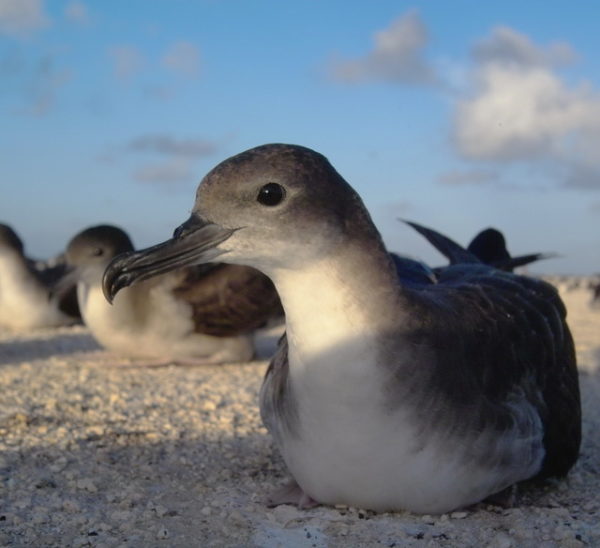Published in the Ocean Watch column, Honolulu Star-Advertiser © Susan Scott
November 5, 2016
Honu is still inside the Great Barrier Reef, but because we’re on the move and near neither reef, islands nor mainland, the sailing feels a bit like Hawaii. Except we miss the wedgies.
“Wedgie” is the nickname of the wedge-tailed shearwater, the graceful seabird that soars over open ocean waves, nearly touching wings to water.
The windier and wavier the better for these 12-inch-long birds with 2-foot-wide wingspans. In rough weather, wedgies zip through the air-water interface like feathered hovercraft.
 Wedgies, or wedge-tailed shearwaters, have haunting nighttime
Wedgies, or wedge-tailed shearwaters, have haunting nighttime
mating calls that can sound like groans or screeches.
Courtesy Alex Wegmann
I have loved these gray-backed, white-bellied seabirds from the first time I heard them moaning at Tern Island in Hawaii’s Northwestern chain. Their nighttime mating calls ranged from dying groans to tortured screeches, often so humanlike it sounded like we were hosting a wartime field hospital under the house.
But those agonized sounds come from the most charming of birds. Besides their bills forming a permanent smile, wedgies are gentle creatures, perhaps delivering a small peck in fear but quickly settling down in workers’ hands during rescues and ID banding.
Around the Hawaiian Islands, wedgies form what anglers call bird piles, feeding frenzies that occur when large fish chase small fish to the surface. Pity the little fish. In leaping free of tuna teeth, the fish winds up in the belly of a bird.
Anglers look for bird piles to know where to fish.
Bird piles often occur here inside GBR waters, but the ones we’ve seen consist of beefy crested terns, black and white birds that are always having a bad hair day.
Some of Australia’s GBR islands host wedgie colonies, but breeding time here is opposite Hawaii’s. Here the mated-for-life couples are just starting the work of digging a nest, brooding the egg and raising their one chick.
In Hawaii wedgie parents are done parenting for the year. For most of this month, their chicks will be flying from their burrow homes at Kaena Point, Black Point and several islands off Oahu. The lucky ones make it to the ocean on their maiden flights.
The unlucky will get disoriented by lights, hit wires and poles and end up on doorsteps, sidewalks and roads.
The good news is that often the downed youngsters are just stunned and can be saved.
You can help Hawaii’s wedgies by keeping near-shore lanai, garden and garage lights off through November. If you find a stunned fledgling, put it in a covered, ventilated shoe box (they grow up in holes so are calm there) and take it to Sea Life Park. Or contact official wedgie helpers at hawaiiwildlifecenter.org/seabird-fallout-response.html or oahuseabirdgroup.org/how-you-can-help.